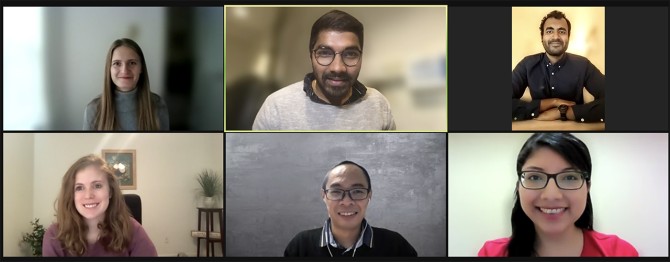Student team creates award-winning food concept for NASA
By Krisy Gashler
A team of six graduate students in food science, mechanical engineering and biological engineering is among the winners of Phase 1 of the NASA Deep Space Food Challenge, an international competition that seeks novel food technologies to provide safe, nutritious foods for long-duration space missions to the moon, the International Space Station and eventually to Mars.
The student team, named BigRedBites in a nod to Cornell and Mars, developed a compact symbiotic food system concept that produces mushrooms, fresh vegetables and plant-based meat alternatives in various sizes and textures, such as patties, meatballs and chips, and provides approximately 15% of an astronaut’s daily calorie requirements.
The system minimizes the amount of soil, water and nutrients needed, and maximizes diverse food production by creating interconnected subsystems that benefit from one another. Individual subsystems produce cyanobacteria and yeast, plants and mushrooms. Waste products from each system, such as carbon dioxide, oxygen and water, are then recycled into other subsystems, where they can be used to grow additional food. Innovations like 3D-printed artificial soil further reduce the amount of materials astronauts would have to carry into space.
“Our team was very nutrition-driven,” said Viviana Rivera Flores, a doctoral student in the field of food science. “One of the first things we did was work to understand the nutrient requirements of astronauts in space based on what activities they’re doing and how they’re performing those activities. That kind of set the stage for what we were going to create.”
The Cornell team’s entry was compelling because it would produce a variety of foods, and variety is important for astronauts’ nutrition and food palatability, said Ralph Fritsche, senior project manager for space crop production in support of deep space exploration at NASA. Critical nutrients such as vitamin C and vitamin K degrade over time in packaged foods, so developing space-based crop production is critical for long-duration missions, he said.
Piyush Jain, a doctoral candidate in the field of mechanical engineering, said the interdisciplinary nature of the team strengthened its submission.
“Having people from different backgrounds and interests come together enabled us to solve these challenges in novel ways,” Jain said. “We are thankful for this ecosystem here at Cornell, which allows for opportunities like this.”
In addition to Jain and Rivera Flores, the BigRedBites team members are team captain Brenna Flynn, M.S. ’21; food science doctoral students Mark Emile Punzalan and Andreea Beldie; and biological engineering doctoral student Kalayarasan Seranthian.
NASA, which began Phase 1 of the challenge in January, announced last week that 18 U.S. teams and 10 international teams were chosen. Each of the U.S.-based Phase 1 winning teams was awarded $25,000. In Phase 2, winning teams will be invited to develop a prototype of their food system concepts to present to NASA, Fritsche said. The timeline for Phase 2 is still being developed, he said.
“One of the benefits of this challenge was engaging with universities like Cornell, engaging with young people, and exposing them to some of the challenges we’re facing that we won’t be able to solve within our careers,” Fritsche said. “It’s a great way for us to see interesting, novel ideas, and it gives them insights into what the future could hold for them.”
Krisy Gashler is a writer for the College of Agriculture and Life Sciences.
Media Contact
Get Cornell news delivered right to your inbox.
Subscribe

